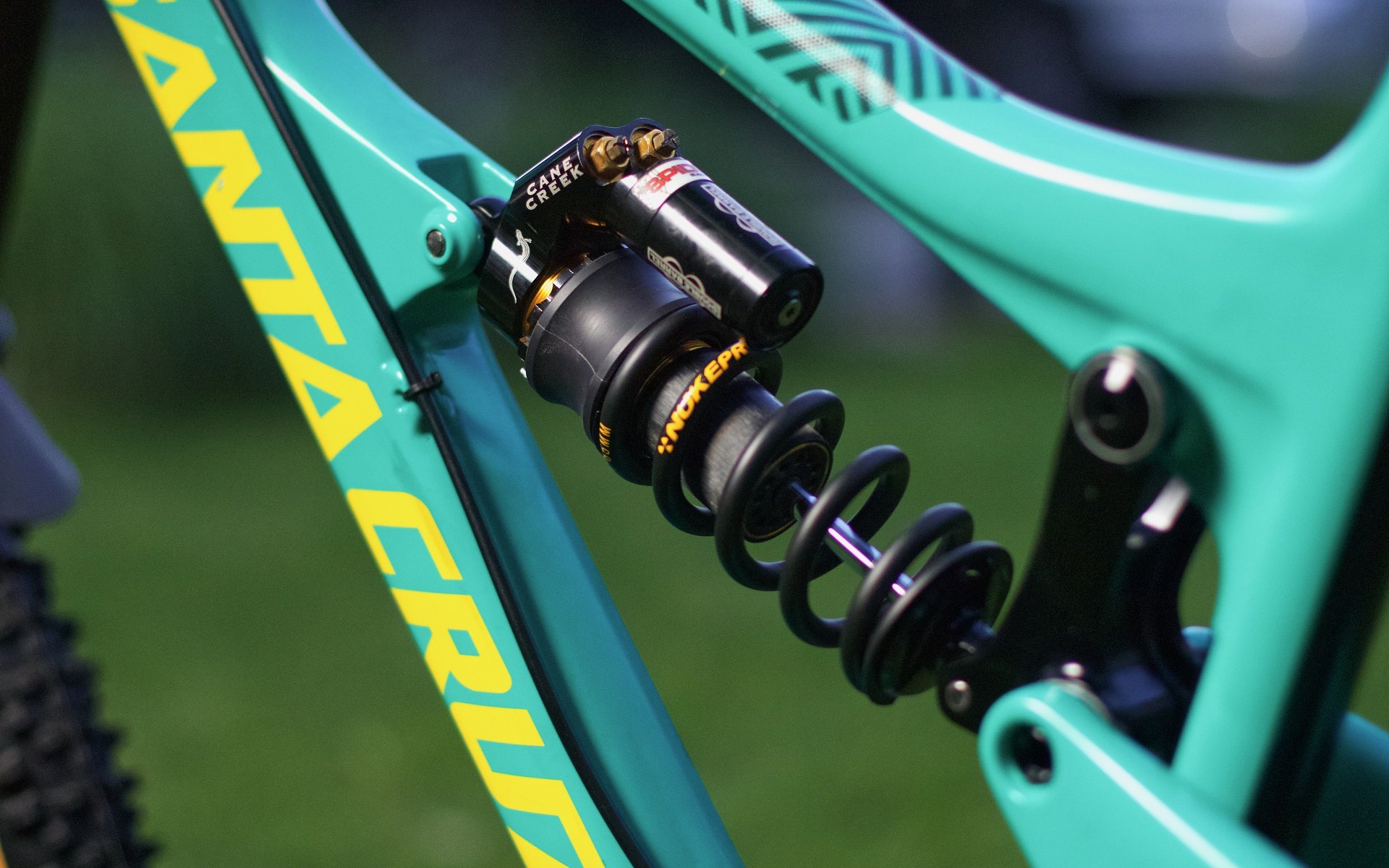
MIN MAX | EDITORIAL
Min-Max: Adam's 2016 Santa Cruz Nomad & The SCB Ten-Year Guarantee
We've committed to holding replacement parts for 10+ years after a model (or version of a model) is discontinued." - Garen Becker, Santa Cruz Bicycles
Forward To 2026
"The investment is mostly in the hours it takes to make the product initially, with the mindset of designing something that will last, where wear items are replaceable and affordable, and big expensive pieces don't wear or break. After that, we've got some wild computers and smart people that know how to use them, so making another batch of hardware appear before we run out isn't the most difficult thing we've done..." - Garen Becker, Santa Cruz Bicycles (SCB)
I think my favourite part of Adam's bike is that he just did a full bearing overhaul and it was fairly nasty. I didn't ask him how draconian the process was, but I've seen plenty of shafts that looked similar and it's rare that a few kind words are enough to expel them from a frame. But, his bike came out looking and feeling fresh and, while it's been years since I rode a Nomad V3, based on my memories it's fantastic on trail. It climbs surprisingly well for a bike with 165mm rear travel, the geometry is close-enough to what's current, it was much easier to setup than past VPP bikes I'd ridden, and it went fast downhill. If you're interested in digging a bit deeper, Pete had more hours on the bike than I did, and wrote an extensive long term review.
While I was riding the bike I never thought I'd be talking about it in 2022. I'd owned plenty of hardtails as longer term investments but full suspension bikes were still been developing quickly and I was as caught up as anyone in the "next-generation means significantly better" bicycles mentality. As it sits now, I'd like to follow up with Adam, or whoever owns this Nomad, in 2026 and see what it looks like after another four years of use.
Here's my standard min-max prediction right now:
- -1° angleset
- 29" front wheel mullet with 160mm fork
- Black tires
- That same tried-and-true, pre-climb switch, Cane Creek DB Coil shock.
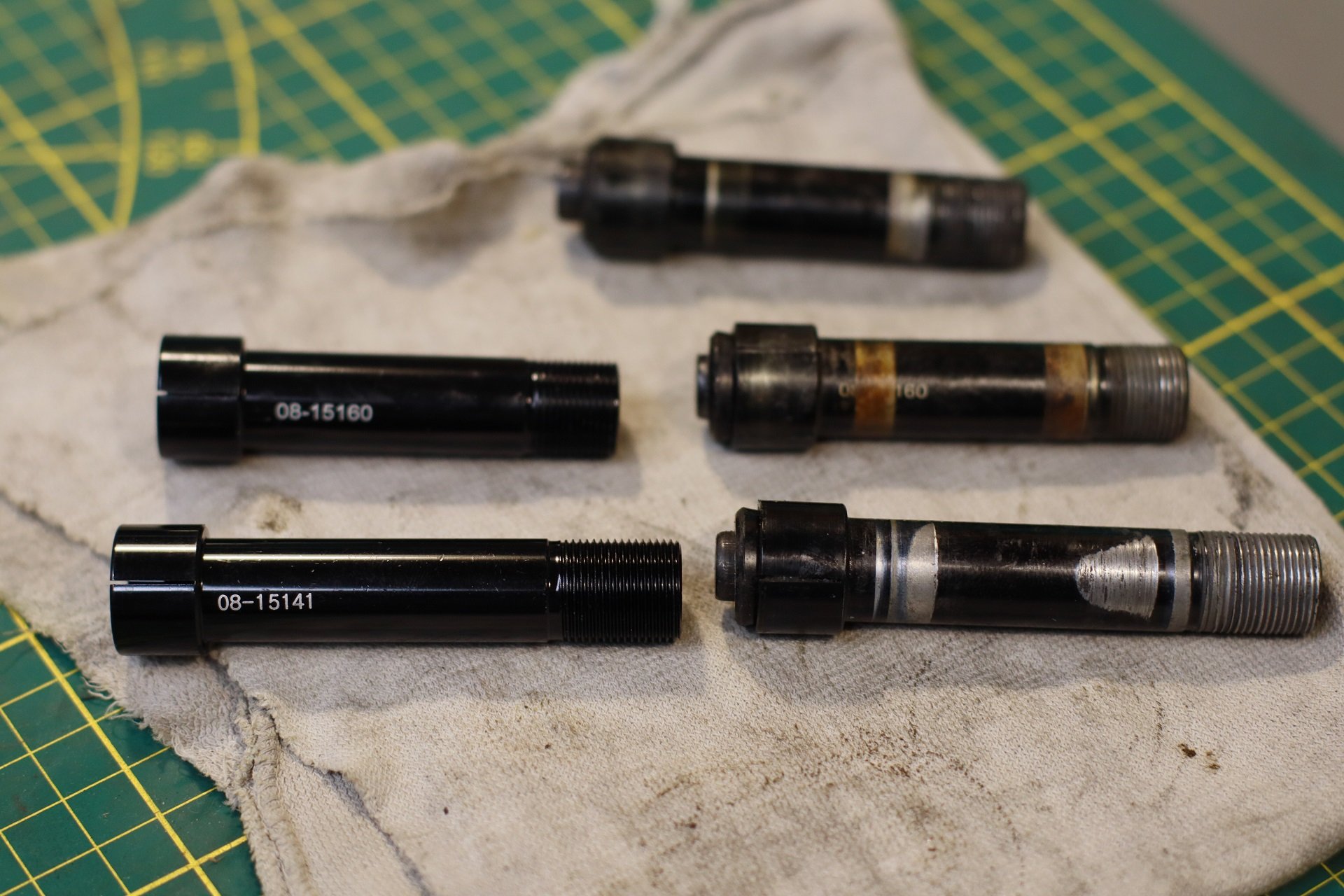
The frame hardware is common throughout Santa Cruz's lineup so every dealer has what you need in stock or in a pinch you can rob an axle from your a friend's rig if they're also on an SCB.
In my experience, based on how their bikes ride, are designed, and how they are supported, Santa Cruz delivers a lot of value. Their in-house assembly setup produces significantly better built bikes than most of their competition which can save headaches and heartaches down the road.
As part of an article I've been working on, I traded some e-mails with Garen Becker from Santa Cruz Bicycles, with the plan to take what I call the SCB Design Philosophy to other companies for comment. After mulling it over, I realized the plan was flawed. What's the point of asking a company that doesn't have a chainstay available (for the bike they sold three months ago) about their vision of supporting said bike ten years from now?
Credit goes from Garen to SCB Product Manager Josh Kissner, a twenty year veteran of the company, and the fact that "over the years the product and design teams came from the bike shops in the first place." Josh spent time in production and then as a rider support rep for years before becoming Santa Cruz's engineering tech. Between Josh, and former shop wrenches working at SCB, being hands on with the product, they weren't willing to produce anything that was difficult to work on. That meant avoiding bandwagon products like the (soon to be dead for MTB?) pressfit bottom bracket, or internal cable routing before they pioneered their internal tunnel system.
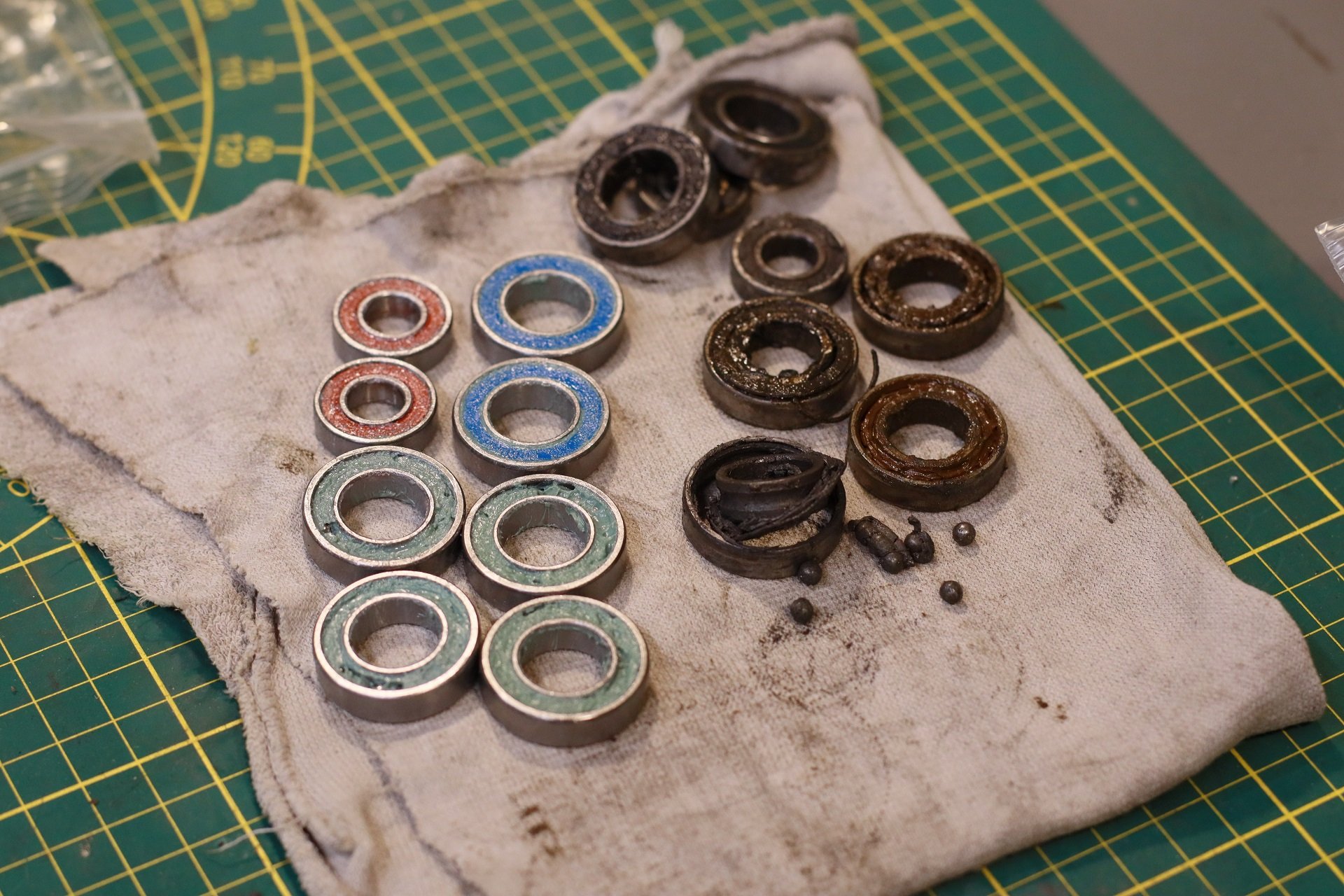
Santa Cruz has a lifetime bearing warranty for the first owner of their frames. Even if your Nomad was bought used, or it's Friday night and you need to swap the bearings before tomorrow's ride, they're common sizes and really not expensive. The frames are well shielded and they tend to go multiple seasons. Take those axles out and grease them once in a while though.
"We've committed to holding replacement parts for 10+ years after a model (or version of a model) is discontinued. This means all frame parts: bearings, links, axles, etc. We try to hold front and rear triangles too, but when those run out and we need to support a warranty claim, we'd then move that rider to a newer version. Most riders seem pretty eager to upgrade to a later model, but there have been times when a customer is SET on rebuilding their classic bike so we've supplied CAD drawings so they're able to get the part made at their local machine shop." - Garen Becker, Santa Cruz Bicycles (SCB)
There will always folks arguing that Adam would be better served by selling his V3 Nomad. The Reach is too short. The seat tube angle (STA) is too slack. His 2016 was the last year of production for this particular model so this is a six or seven year old rig but it's arguably a design that's now nine model years old. What's the value in something that lasts forever if the new model is significantly improved? But from where I sit looking at the activity of mountain biking I think ten years is a great minimum level of support for anything proprietary whether its a fitting, linkage, frame component of a shock like Fox/Cannondale's DYAD.
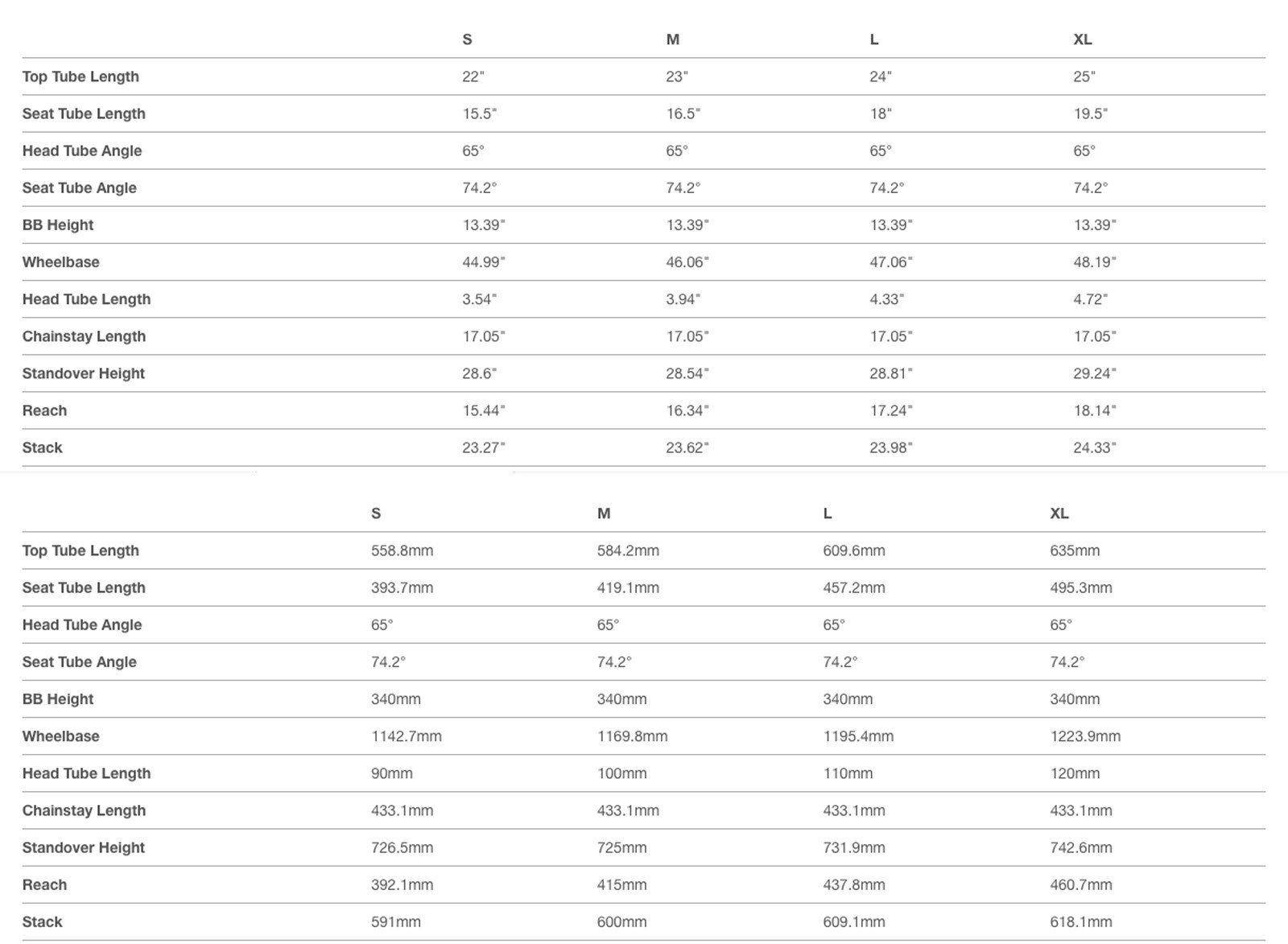
You probably aren't running a stem shorter than 50mm on a V3 Nomad, and sizing up was a thing for a lot of riders even when these bikes were new. At 5'9" I spent a fair number of rides on a large with a 50mm stem and it was a fantastic bike.
On Value
Continuing with the theme of the personal nature of value, I was part of an exchange recently where the new Santa Cruz Nomad VI was being used as the price point punching bag relative to a just-released carbon fiber e-bike with a Shimano EP8 motor and another bike from a popular direct-to-consumer (DTC) brand's bike with similar spec and travel.*
The conversation was with a friend who is planning to switch to a plug-in full time for all the standard justifications, so in his world value is measured by being able to do a properly satisfying door-to-door ride in under-an-hour. Clearly for the same price then, the EP8 option is his winner because the particular bike aligns with his DTC bike example on spec. The fact that the price difference reflects only the addition of the motor and battery, and comes from his local bike shop, is a source celebration for him. Honestly, for how much the bike is going to be ridden, issues that would detract from it's value may never come up. The DTC bike has a similar spec. to the Nomad for notably less scratch and the EP8-equipped rig costs about the same as the SCB he'd be buying.
If we assume the quality and performance of all three bikes is the same, what other value factors should be taken into account? Even ignoring the cheeky memes about eMTB owners communicating with each other via smoke signals - new month, new recall - the fact is that if you're looking to own a rig that's always ready to go at a moment's notice, e-bikes simply aren't there yet. Look online and there are legions of riders going months with six-figure clothes drying racks because their Shimano motor shat the bed and there are no replacement units available.
*With shipping, duties, and professional assembly taken into account.
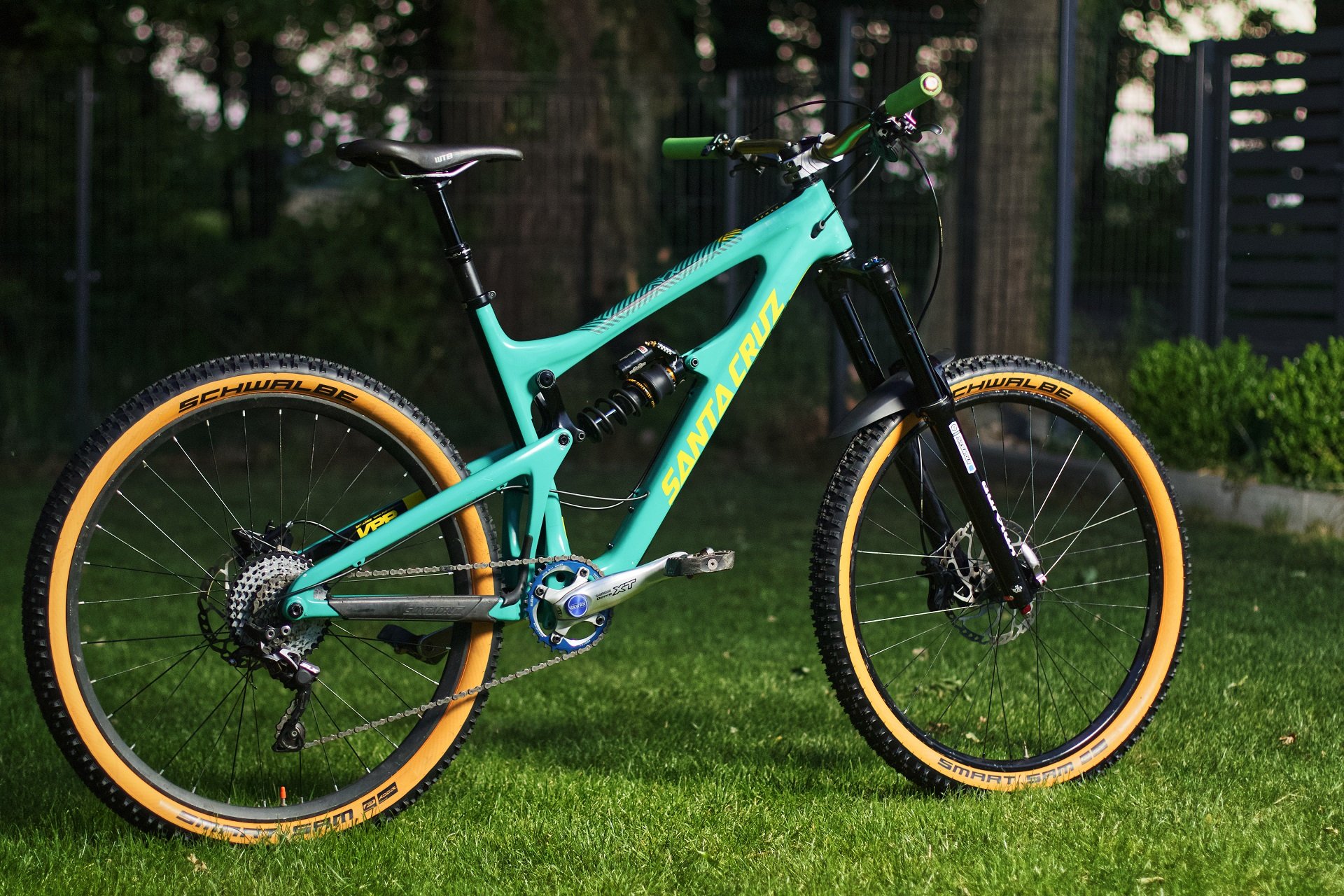
Adam's Nomad shows it's an older generation in a few ways, like the IS rear brake tabs and the four-bolt crankset, but it's still great looking frame. He doesn't have a water bottle mounted, but not there is room below the horizontally-positioned shock.
The DTC brand in question has a horrific reputation for warranty replacement timelines and long term support for frame members. Buying one of their frames used is most certainly gambling and even new I'd say a strong selling feature is that everything on the bike will swap over to a Chromag Rootdown or Kona Honzo frame so you can fall in love with hardtailing again while you wait patiently for frame members to arrive. Maybe you've never broken a frame, and generally flip your bikes before they need a suspension service or bearing overhaul, and are more of a fair-weather rider, and have lots of activities you can do, or multiple bikes, in order to get through the downtime. In that case, our definition of value is very different.
I have multiple friends who've cracked Santa Cruz frames - everything breaks occasionally - that were covered by warranty, who were riding again within a week. They're among the easiest multi-pivot full-suspension bikes to service and they've used common suspension hardware through the whole lineup for years so every dealer has every shaft and bolt you could need. They're very well thought out and easy to work on bikes. Yes, they're expensive up front. For a rider who's going to put a ton of hours on their bike, and treat it like a mountain bike, and wants minimum downtime whether it's doing repairs or waiting for a warranty, their bikes and reputation add up to something.
Looking back to 2016, I know many riders who paid significantly less for a better equipped rolling port-a-loo than they would have paid for a Nomad III. And not one of them is still on that bike. But I still see plenty of these, and older Nomad frames on the trails under both their original owners and new riders who undoubtedly paid a bit of 'Santa Cruz tax' to buy into a product with guaranteed long term support.
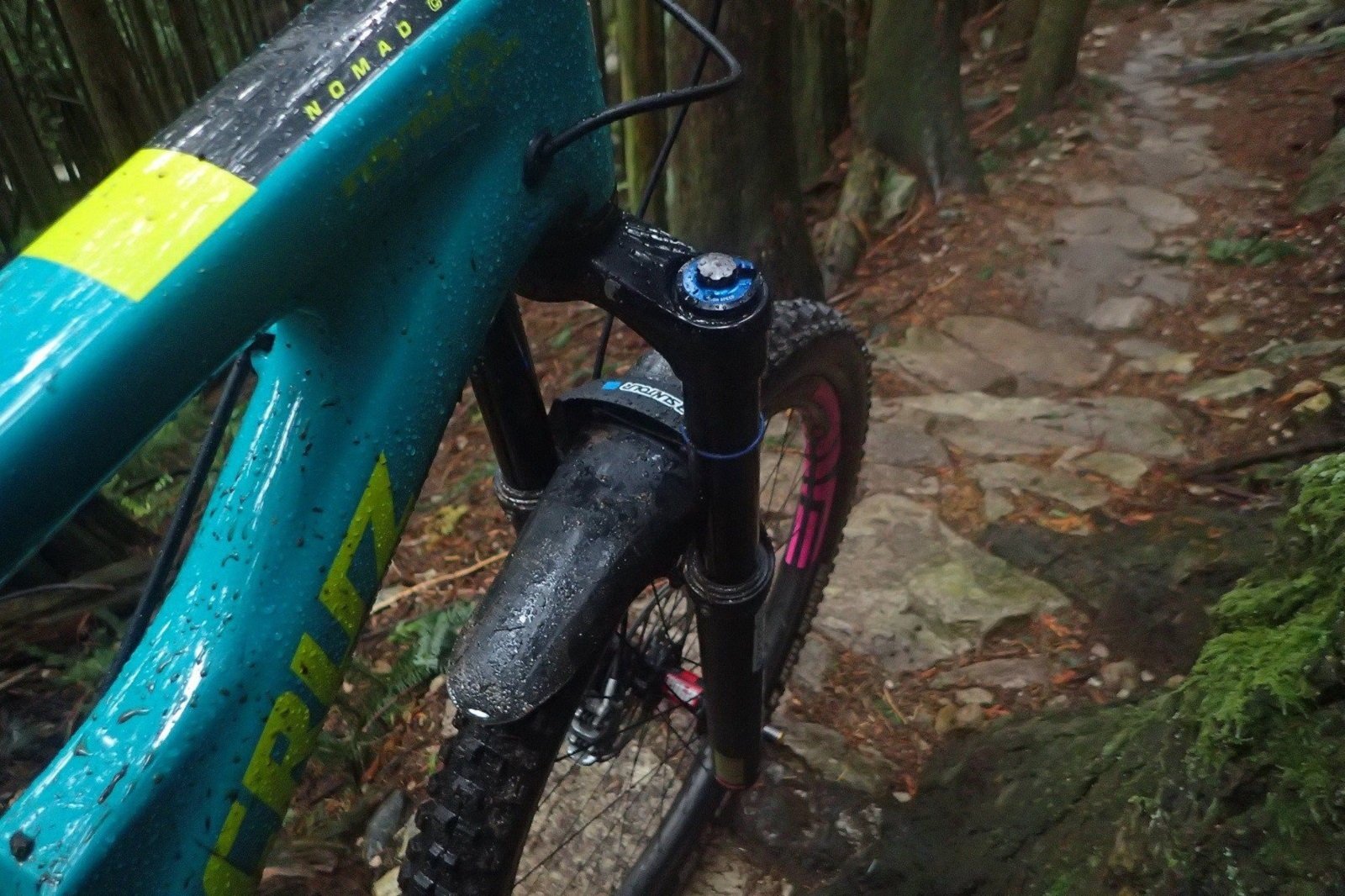
I rode the same setup that Adam is on, a Nomad V3 with an SR Suntour Durolux. Photo: Andrew Major
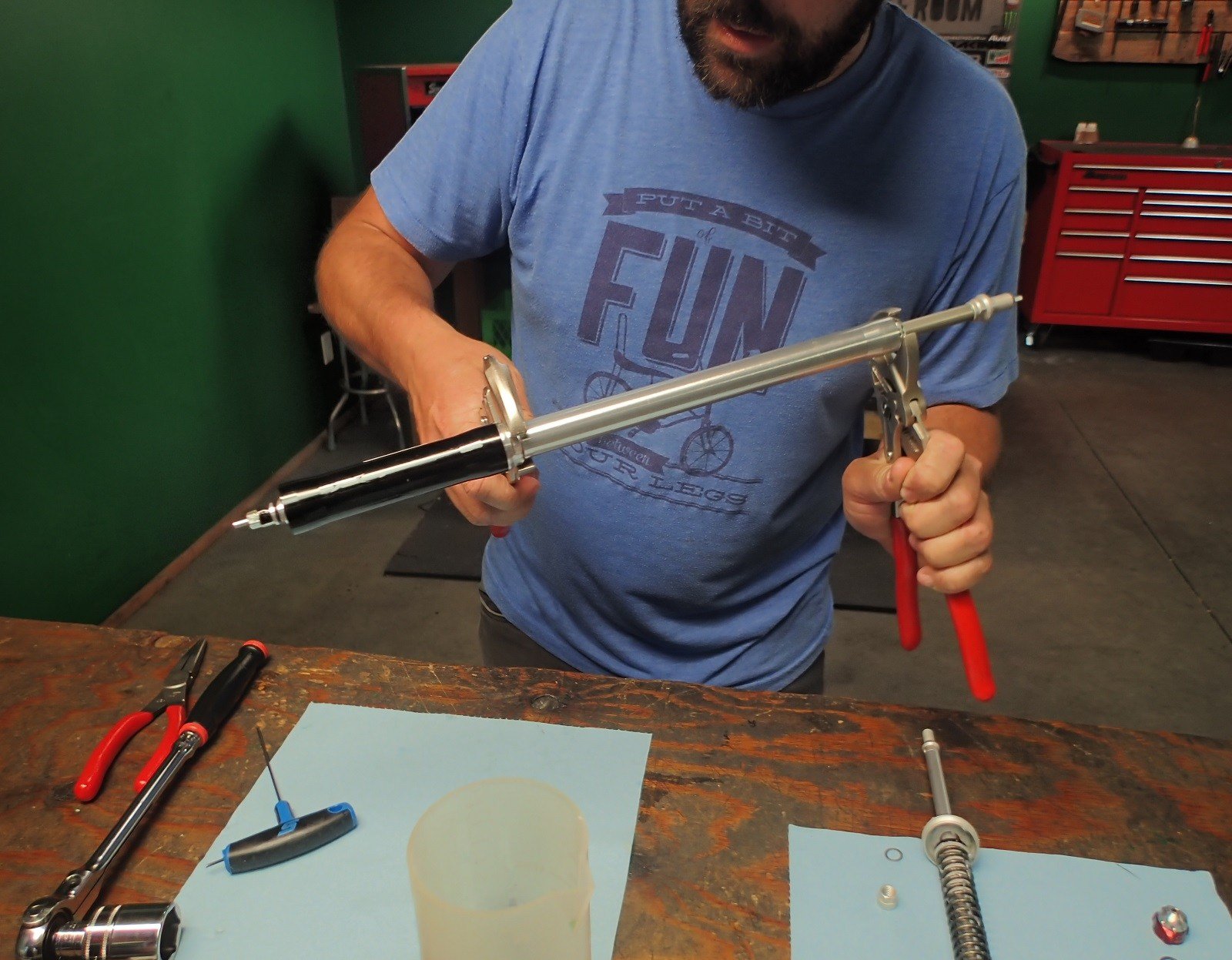
It was actually one of the first teardown pieces that Bikeroom Jeff and I did together. Photo: Andrew Major
'Simply Advanced'
Adam's Nomad has worn an array of parts and when we first started talking about putting together a min-max piece he was deciding between a couple of suspension forks. I can picture riding the bike because I rode a Nomad V3 while testing an SR Suntour Durolux. When it comes to rebuilding a fork at home, any generation of Durolux is about as user friendly as it gets and Adam just put his back together as part of this project.
I've never owned a Santa Cruz but I've reviewed a few generations of their Chameleon hardtails. I have however ridden quite a few Nomads, and worked on many more, going back to my brother's aluminum V1, and I quite enjoy them. I think the new Bronson MX will be very neat once they have an aluminum option on the market and, of course, the aluminum Tallboy is right up my alley in terms of balancing all the value I see from their design philosophy with my budget range for a new bicycle.
But, if we're talking used bikes in good condition for potential min-max projects, the Nomad V3 or later Bronson V3 would both be high on my list for potential candidates, either in aluminum for the lower price or in carbon with the knowledge that the frame quality makes them worthy candidates for a repair at Robert's Composites if disaster should occur. In either event, a larger frame, a 29'er fork with a bit less travel than the stock 27" number, an angleset, and a 29" front wheel would make for a very fun bike; no trunnion mount, no funky chainline, no faffing with stuff designed by someone who's clearly never worked on a bicycle. Awesome.
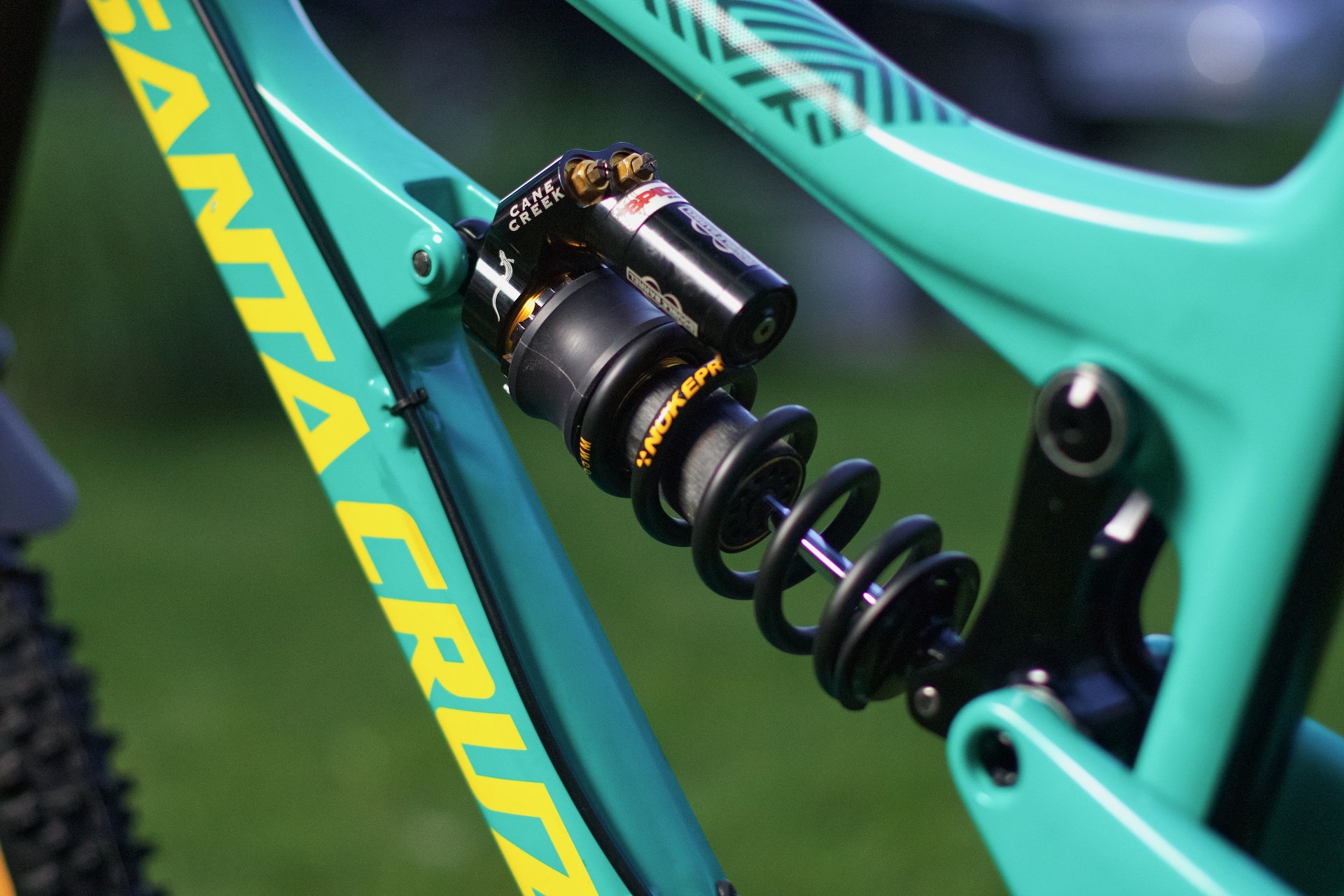
Regular-sized shock, with regular eyelets, attached to a one-piece linkage. Horizontal orientation with room for a water bottle and a piggyback. A classic, pre-Climb Switch, CCDB Coil shock that will run forever with routine maintenance thanks to excellent product support from Cane Creek. I think everything about this photo is beautiful.
Adam's Nomad is running a stalwart Shimano 10-speed drivetrain. It includes a Zee shifter, an SLX rear derailleur and a 40t expander cog on the cassette. As products wear he'll be able to swap that over to a SunRace 10-speed cassette and a Deore 11-speed rear derailleur will happily take commands from the 10-seed Zee shifter that could very well outlive everything else on the bike.
If he's looking to hit lower gears and doesn't mind giving up a bit of top end then North Shore Billet manufactures a 64/4-bolt narrow wide ring that sits outboard enough to clear many bikes that weren't designed to accommodate a front derailleur and granny ring setup. I used to run this setup on my daughter's 20" bike and it will allow allow Adam to drop to a 26t or 28t ring.
In many people's experience the 1x-specific VPP bikes ride better using larger chainrings. I know at least two riders who swore by 34t rings on their V3 Nomads so it may be preferable from a suspension perspective to switch to an 11-speed derailleur and 11-46t cassette instead. I've also met riders running this very bike with direct mount cranksets using similarly small chainrings who say they work fine.
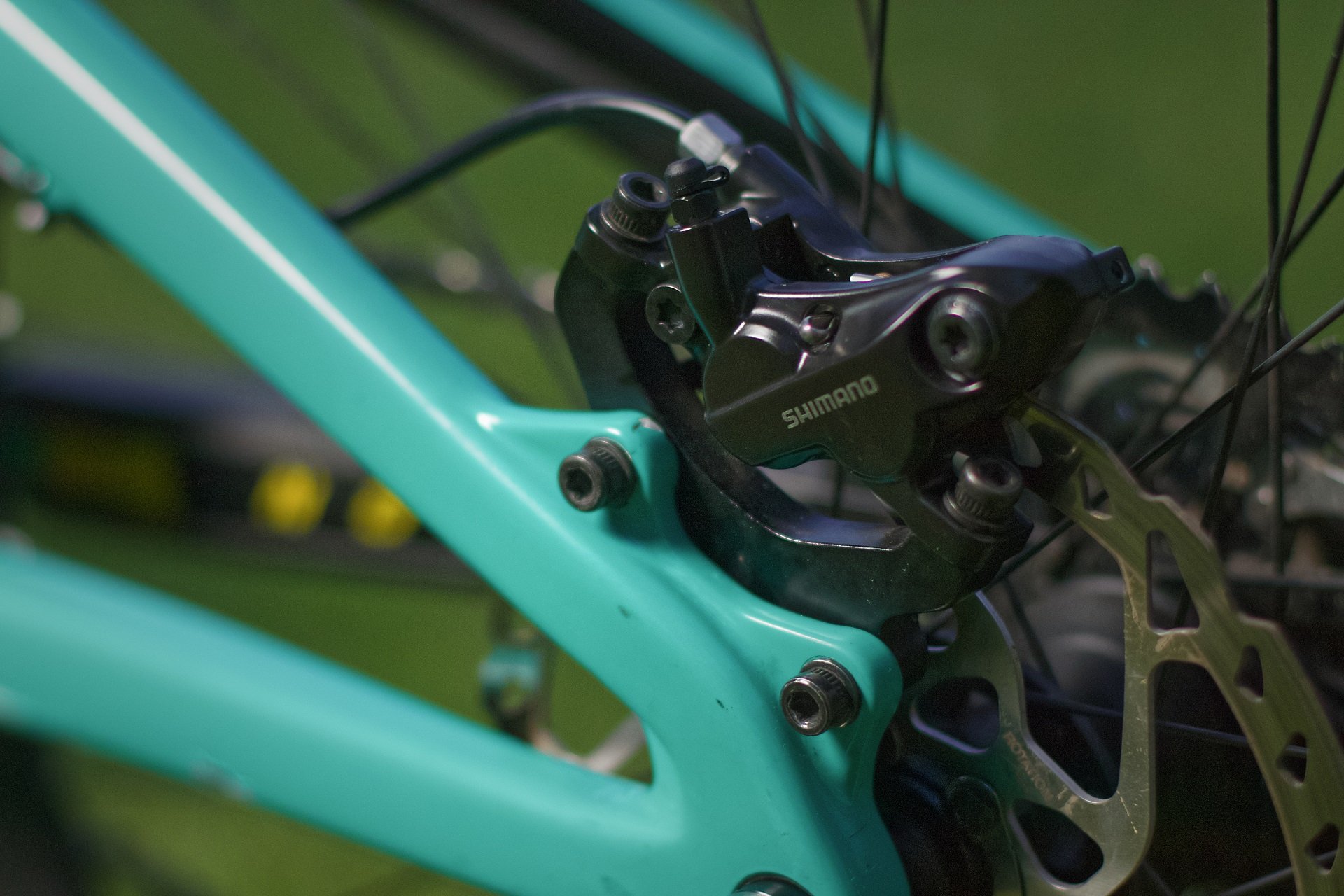
I will never understand why the industry went away from IS brake mounting on frames or forks. Put all the threads in a cheap and replaceable aluminum adapter that cleanly attaches two expensive parts together.
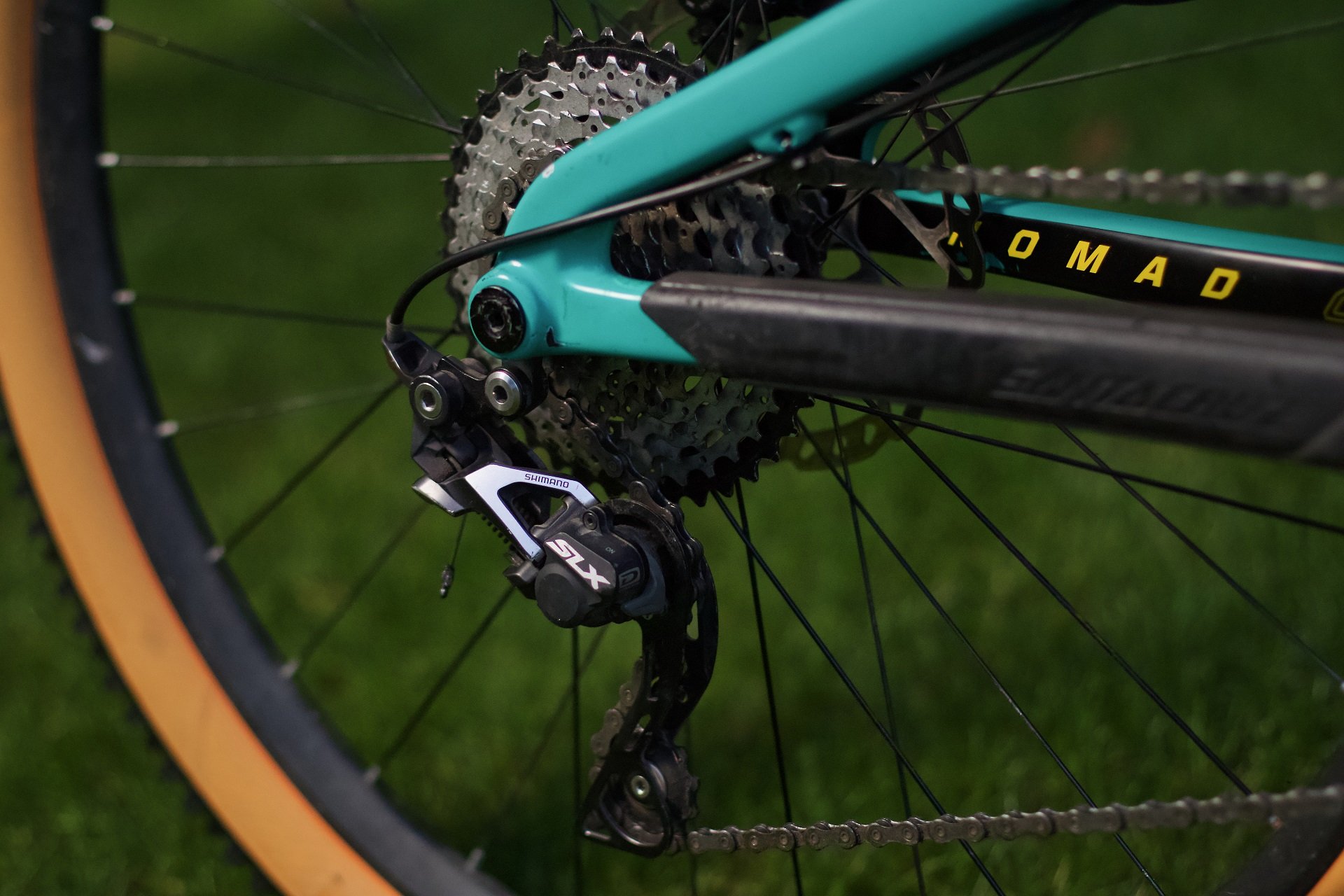
Shimano's 10-speed and 11-speed components talk to each other very well (if not perfectly). When this SLX kicks the bucket an 11-speed Deore rear derailleur is an excellent min-max friendly replacement.
Adam's CCDB rear shock predates the Nomad by a few years, and also is older than the 2014 Orange Alpine that he acquired it with. I'd love to know the full provenance of some used bike parts. How many bikes was this shock on before the Nomad? I bring it up because part of Adam's decision to jump on this V3 Nomad is that it uses the same 216x63mm rear shock. I'd argue that this Nomad is worth a bunch more to the average rider now that the frame and fork have been serviced, so even if he does decide to try something else, Adam should be able to get a return on all the effort that he's invested in addition to the fun he has riding the bike in the meantime.
Thinking about Claire's 2009 Kona or Daniele's 2013 MDE, a common thread is that, like this Nomad, the majority of the maintenance work being done is by the owners. They're investing time and they have to have worked to acquire the skills, tools, and knowledge to make this happen, but those things are amortized differently than just heading to the shop and paying to have work done. That said, over the last few years I've been part of a few of these projects either lending advice or on the clock wielding tools and, if riders already own the bike (sunk cost) or are getting a great deal on an older rig in good shape, you can come out way ahead in terms of fun on two wheels per dollar. I think that's especially true with bikes sporting almost-current geometry.
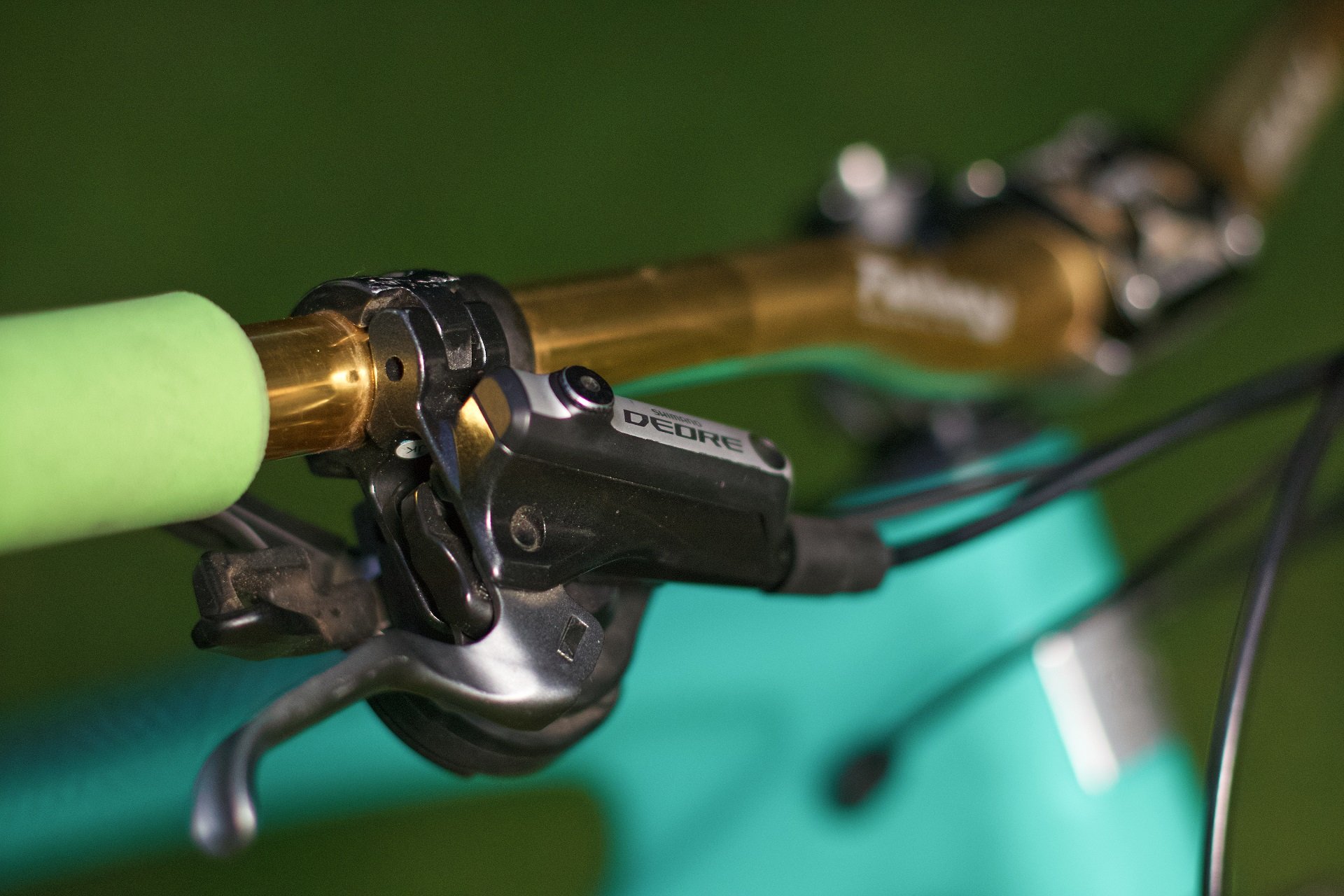
Answer 50mm stem, 765mm Funn Fatboy bars, Shore-Country-Quinn approved ESI foam grips, Zee shifter, and freshly serviced Shimano 4-piston brakes.
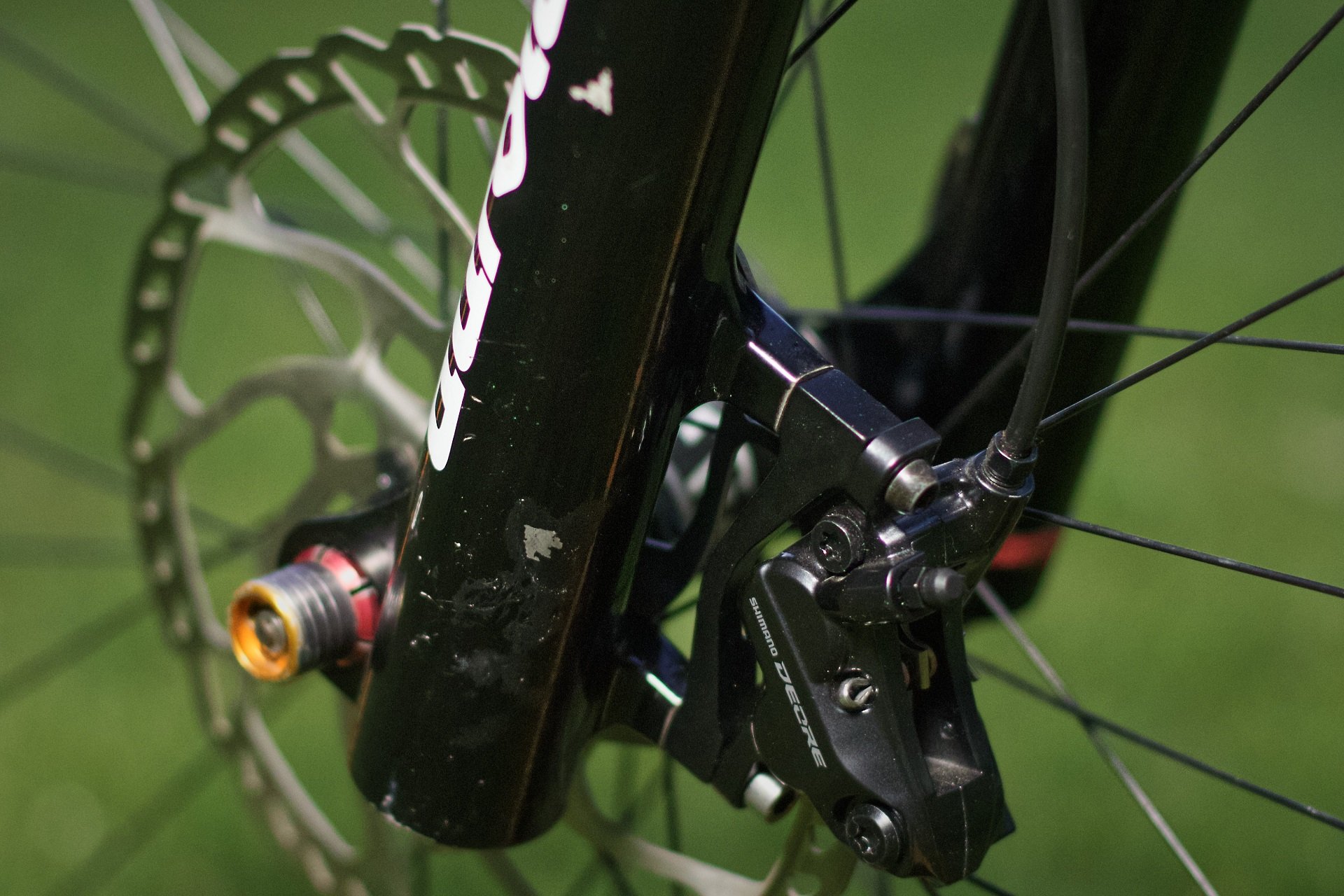
The SR Durolux fork and KS dropper post both also received a service for this min-max build. Adam's a lot more patient than I. If this was my bike that KS post would be getting turned into pop-cans.
There is that ugly buyer beware flip-side that's always worthy of addressing again and again. It's a lot harder to go wrong with a Santa Cruz of a similar generation to Adam's than it is with a lot of bikes. All the parts are still available, you can strip the frame down with nothing but some hex keys and maybe a mallet if the hardware is seized, and rims and tires are readily available for a 27" bike. In fact, with most gravel bikes using a 142x12mm rear, it's not even hard to find a replacement non-Boost hub. A Boostinator kit is always an option to keep the front wheel, or hub, in action if a fork upgrade is necessary. Every other part falls under the standard terms of bicycles as adult Lego.
Does the long term support increase the resale value, and long term used value of a mountain bike? I've seen so many folks devastated after buying someone else's recycling for thousands of dollars that I don't know if that's the case. Does it warrant spending more on a mountain bike up front, particularly for a rider who plans to keep it for years? Looking at how geometry progression has slowed it's not a stretch to believe that if I bought the right bike in 2022 I could very happily be riding it in 2032. In all events, I think Santa Cruz Bicycles' philosophy of a ten-plus year commitment to support everything they sell is rad and worth highlighting. It's also worth asking other companies to show the same commitment.
Thank you to Adam. If you'd like to submit a bike for min-max, hit me with an e-mail. We've probably had enough different rigs now that we could start accepting Kona Process V1 and Banshee V2 bikes again.
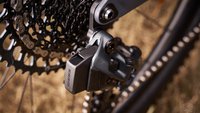
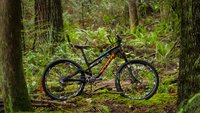
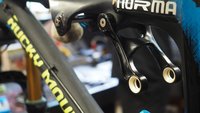








Comments
danithemechanic
1 year, 7 months ago
Santa Cruz are pricey, so pricey that newbie riders don't understand really why.
Now i think i can use this article to explain it: wich other company's bikes you can still ride 10 years after purchase AND have a warranty on them!?
When i was looking to replace the Mde i've been looking at their aluminum models extensivly.
I'm afraid to say it, but maybe all bikes should cost more, be more maintenance friendly and have a better warranty.
I'm suprised the reach on this Nomad is really short for a 27 from 2016 though, even for me, and upsizing unfortunately is something i won't do anymore because i found out that st lenght is crucial for my riding style.
Reply
Andrew Major
1 year, 7 months ago
In terms of Reach numbers, do note the seat tube angle. The Nomad has plenty of room in terms of effective top tube length for seated climbing and I found the fit quite good with a 50mm stem, despite it being shorter than my go-to setup. Good point regarding seat tube length. I could still run a 180mm OneUp post in a large but folks with shorter legs relative to their torso could run into having to run a shorter dropper post than they want.
There are other companies that support their products solidly for years and years - Trek always comes to my mind - but I like that Santa Cruz puts it right out there in terms of making a commitment. I certainly think that has value. Kona also has historically done a great job with having spares, but again I'd like to see a public commitment like SCB has both made and then proven to follow through with.
Not everyone is willing to pay more upfront, or accept lower-end parts for the same money, in exchange for the longer-term resilience, ease of maintenance, and product support that, for example, Santa Cruz brings to the trail. But I know too many disappointed riders who would have paid the extra up front if they had been aware of how much downtime they were going to experience with the "better deal" they ended up riding.
Reply
Lu Kz
1 year, 7 months ago
From a sustainability standpoint, I have to tip my hat to Santa Cruz compared to Trek - they offer support for a bit longer.
From a customer service standpoint, Trek is better in my experience. Their preference is to get riders on a new bike at an amazing deal, even when parts are available to get their old bike running. Deals are free/excellent for original owners, but have been very respectable for subsequent owners in my experience. Great for consumers, not as great for sustainability.
Reply
Andrew Major
1 year, 7 months ago
Repair over replace should be every brands goal in ‘22 dnd beyond no matter frame material or where it’s initially made.
Reply
Cr4w
1 year, 7 months ago
The only other company I've heard of offering that level of parts support is Nicolai. It's great that SC does too. What kind of company just abandons their old customers?
Reply
Andrew Major
1 year, 7 months ago
Most of them? It’s certainly not a bicycle-industry thing either.
There are many great long-term support stories from other brands but I’d love to see the long term product support philosophy codified. Dare to say “we’ll support this bike for a decade.”
Reply
cheapondirt
1 year, 7 months ago
I'd love to see this as well. There isn't much incentive: 3/4 of riders polled on that other site in 2021 plan to buy a new bike in four years or less.
> How often do you buy a new bike?
>
> 1 year: 11.30%
> 2 years: 23.39%
> 3 years: 25.03%
> 4 years: 15.53%
> 5 years +: 24.76%
It's a chicken/egg question. Are we disincentivized from keeping bikes long term because replacement frame parts don't exist? Or do we just buy new bikes because of the urge to have new shiny things?
Reply
Andrew Major
1 year, 7 months ago
The thing I think it's important to remember is that every year for the last few years geometry has changed less than the year before. HTA, Reach, STA, and even the relationship between Reach and Stack is closer and closer to being settled at a lot of brands.
I do think that rear-centers are going to grow and we may see the average HTA get a little bit steeper as a result but the fact is five years from now, strictly talking about bikes you power yourself, if the bike you bought this year was a solid choice it will be able to go toe-to-toe with a new bike - suspension, geometry, tires, etc.
It's anecdotal, and could also be a matter of age and priorities, and 'rona supply issues, but I see a lot of folks who used to flip bikes yearly hanging on to them longer.
I'm hoping bike companies adapt to this by offering more options - like different rear-centers, linkages, etc - as hop-ups but at least for now I think this trend is clearly reflected in how much energy companies are putting into BroPeds which is a rapidly evolving segment where clearly a rig in five years is going to be faster, lighter, and much better looking than what is for sale today.
Reply
Timer
1 year, 7 months ago
This is also a very skewed sample. The fraction of bike gear nerds, who gobble up new and shiny bike tech whenever possible, is certainly higher on that site than in the shops.
Reply
Andrew Major
1 year, 7 months ago
This is a good point but it's probably no less accurate than what we'd get by poling riders at various trailheads. I saw a much higher proportion of older bikes recently in Cumberland than on an average day on Fromme for example.
More interesting would be comparing those numbers on Pinkbike to the same question asked next year, and the year after, especially if e-bikes were excluded from the answer.
olaa
1 year, 7 months ago
Fond memories of my SC Nomad in Miami Vice colours! That bike was great, and maintenance was so easy. Saw my old bike a few months ago, still going strong and being ridden several times a week by the guy who bought it from me.
Serviceability and support should be more important in reviews. It is such an important factor for how a bike is to own over time. It's one of the reasons why I ended up with my Crossworx Dash, it has standard size (and very oversized) bearings that are easy enough to service and replace. The whole bike is built to be used hard and to be easy to own, even without all the specialized tools. That is a win in my book!
Reply
Andrew Major
1 year, 7 months ago
I think there’s a strong teardown argument to doing a complete bearing/pivot overhaul as part of ‘long term review’ even though the bike shouldn’t need it.
Support and quality are much more difficult to write about. I was reading the other day about a company who is having quite an adventure with BB shells failing on their carbon rigs (BB is walking in the shell). This would obviously be covered under warranty but they have no frames ready to go so first they tried to claim it was just paint cracks (f*ck off) and then when stuff actually started failing they had no plan in place and folks are/were waiting months. That sucks.
Not saying any company is perfect. Rocky had their Instinct/Pipeline aluminum frame recall relatively recently, Santa Cruz had an issue with aluminum frames not getting properly heat treated, etc. But there’s a big difference between one-offs and the norm that is, either way, hard to bring into a review of a single example of a bike/frame being reviewed.
And I guess that’s a long way of saying, you’re 100% right but that doesn’t mean there’s a great way to incorporate or measure support. Especially if brands don’t try and hold themselves to a standard for maintenance ease and product support.
Reply
olaa
1 year, 7 months ago
Just taking the linkages apart usually shows if the frame is built for efficient servicing, so that could be a good middle road for reviews. An added bonus would be that it would give an indication of tolerances.
I totally agree that having trouble with a frame or a model is not a huge issue, as long as the company deals with it properly. They have got to have a plan for it though! I have been on the other side of that problem, when a product from my company started breaking in droves. Turned out that the producer had taken a short-cut and we had not been diligent enough on QC. Luckily we had the possibility to handle warranties within our stock situation, but the bottom line that year (as well as my salary) was terrible. I ended up moving production close to home in order to have better control of the production. Which in these days of disrupted logistics is paying off in many ways :)
Reply
Andrew Major
1 year, 7 months ago
I’ve seen this a few times in shops. Cheaper anodizing finishers or even aluminum than was the spec and other factory switcheroos. Short of making bikes in your own factories, or one at a time yourself even, I don’t know if there’s a perfect fix.
Could point re. linkages. At least shows how tools go in. Plus there is some neat not-the-cheapest-way stuff out there like the locking hardware on the new Process bikes from Kona that goes unmentioned. Cheers!
Reply
Vik Banerjee
1 year, 7 months ago
My 2009 SC Nomad Mk2 did great for me for 9yrs and then I sold it to a buddy who is still riding it after 4 more years. Great bike that was super fun to ride. SC helped me out any time I needed after sales support. Despite being ridden hard year round when I had it the bearings and suspension hardware were very very durable.
If I had a SC bike shortlisted for a new FS rig I would definitely give them some bonus points when it comes to assessing the value proposition vs. other brands.
Reply
Andrew Major
1 year, 7 months ago
My brother had a V1 that I can only imagine has been retired due to the EC34/EC34 & 1-1/8” headtube / steerer arrangement. Though who knows, I saw plenty of those rigs with dual crown forks BITD. Maybe a Boxxer U-Turn coil and it’s still getting shredded?
Then he had a carbon V2, which he rode for years until he bought his aluminum Smash. I’d like to think that thing is still ripping. I couldn’t tell you how many bearing kits I had done, and the PUSH link made the suspension rad.
V2 makes me smile because he picked it up for a great deal when they went to 142x12. I talked to riders who’d been on both who said the backend was already so stiff he’d never notice the difference between 135-QR and 142-Thru and big money off last year’s price vs. the new higher SRP of the non-QR bike sold him.
It was an awesome rig, though clearly the Smash and 29” wheels fit him / suit him better. The current Hightower would be in the running if he needed to buy a new rig tomorrow.
Reply
Sandy James Oates
1 year, 7 months ago
Still ride my V2 carbon, lot’s of time and good memories on it.
Reply
Andrew Major
1 year, 7 months ago
Possible future min-max entry?
Reply
Cooper Quinn
1 year, 7 months ago
Adam has fantastic taste in grips.
Reply
Andrew Major
1 year, 7 months ago
You're welcome for the plug.
Reply
cheapondirt
1 year, 7 months ago
Built and photographed with care that shows; nice work, Adam.
Reply
easy
1 year, 7 months ago
Thanks! need to get the bike dirty though.. ;-)
Reply
Andrew Major
1 year, 7 months ago
Definitely. I can always update the piece with some dirty photos.
Reply
John Hinton
1 year, 7 months ago
The link to the Nomad v3 long term review appears to be broken.
Reply
Andrew Major
1 year, 7 months ago
Thank you for letting me John! I've fixed it and you can also find it here.
Cheers,
Reply
T0m
1 year, 7 months ago
Ibis has moved some carbon production in-house, probably to work out the possibility of larger future production. Started with the Exie, along with in-house polymer coat finishing for the same model. It’s a start. Ibis Exie Mfg
Reply
T0m
1 year, 7 months ago
Sorry this post is on wrong thread- was just an added data point for the list of North American-produced carbon frames. Ibis has plans for this at larger scale than just the Exie, I’d bet.
Reply
Andrew Major
1 year, 7 months ago
No stress. I’m hoping it allows them to add frame repair to the menu. Repair > replace for warranty should be the future for carbon and really all frame materials.
Reply
silverbansheebike
1 year, 7 months ago
Love it!! I never knew about the 10 year support until recently. A friend I've been riding with, I asked him jokingly if he actually liked the Hope brakes on his SCB or if he was just from the UK.... and he was happy to share that he is in it for the long-term product support on the brakes and even the bike, despite often higher up front costs. He's got a crack in his top tube from a public transit bike rack, and they are very eager to replace it for him, no sweat. Damn decent company!
Reply
Frorider
1 year, 7 months ago
I have an XL nomad like this one (matte black) sitting in the shed that I’m thinking of getting completed again (I’ve been raiding it for brakes etc for other bikes). Not sure if article mentioned it, but the short reach is actually even shorter when you consider that the stack is 20-30 mm lower than my more modern XL bikes. I’m an ‘invest & maintain’ long term owner of cars and bikes, and somewhat frustrated that the bike industry spent $$$ on frame development over 20 yrs but somehow still released bikes with crap geometry for taller riders
Reply
Andrew Major
1 year, 7 months ago
I think there are plenty of companies still running significantly too-short head tubes and Stack numbers for their Reach. It’s one reason so many options now exist for taller rise bars. Slam you stem and throw on a FU50 bar and it gets you quite a bit of length back versus headset spacers.
As to the general fit of XL and XXL bikes it’s tough. For every genuinely tall person looking for (really long) size specific stays to balance out their rig there are three who want the shortest rear-centre possible to keep wheelbase shorter with their long front-centres.
I like that there are an increasing number of proper large person bikes but I’m not surprised it took this long to get here or that many companies are still putting short headtubes on big rigs.
Reply
luisgutierod
1 year, 7 months ago
these 2014-2015 crop of bikes, which showed proggressive geo numbers (angles mainly) with shortish reach are good for your growing kids.. provided seat tube is not up in the sky..
My 10yo is riding a current gen XS Transition Scout, mullet, but his next (park) bike will be an used bike for sure.. I have couple old frames, a medium 2016 canfield balance and a medium banshee darkside.. for sure he can hop on any of those and shred.
Reply
Andrew Major
1 year, 7 months ago
Yeah, either need a shorter seat tube or for it to be cut-able in many cases.
Was talking to a reader the other days about how that was the last generation of DH bikes before they started getting the really racey numbers they have now. In terms of used DH bikes. Lots of interesting stuff.
Reply
Alex D
1 year, 7 months ago
> I think there are plenty of companies still running significantly too-short head tubes and Stack numbers for their Reach. It’s one reason so many options now exist for taller rise bars.
All of them. They're all doing this and it's infuriating. The difference in head tube between Specialized SJ in S1 and S6 is 45mm. The difference in rider inseam could easily be 230mm for those sizes. Fox and RS approve 30mm of steerer spacers below the stem and you can't get any rise out of the short stems the bikes are designed for. Which leaves tall riser bars, of which there are essentially zero in carbon. A couple options at 35mm and 38mm, one expensive Enve 50mm bar, and Whiskey's 70mm with a crossbar and a whole lot of backsweep.
The whole thing is a giant middle finger to anyone with long legs who doesn't want XC levels of saddle-bar drop. This reason alone is why I refuse to buy any new bike. No brand will sell it with an uncut steerer, and the idea of spending high-four-figures on something intentionally designed not to fit me, and then intentionally screwed up by the shop, deeply offends me. A riser bar is supposed to be a fit adjustment tool, not stock equipment to make up for a miniscule head tube.
To get the bars close to where they need to be on my XL Trance (which still end up over an inch below the saddle), I'm running a 38mm riser (wasted money; already had a perfectly good bar with less rise) with a cheap 70mm +35D stem. It looks ridiculous.
Reply
Andrew Major
1 year, 7 months ago
I’ve not been in the market for carbon bars for many years so hadn’t considered that. Not plastic fantastic but these ProTaper bars ride really nicely.
As I’m playing with fit with my new flat pedal position I’m going to try them again on my Walt.
No disagreeing that head tubes should be much taller than they are on proper XL bikes (and in general) but I think it’s a nice solution.
Reply
Timer
1 year, 7 months ago
I think Banshee is using pretty tall headtubes and provide lots of stack on their bikes.
Not for super tall people, though, because they don't have XXL frames.
Reply
Andrew Major
1 year, 7 months ago
I’m decidedly a large Banshee at 5’9”. Headtube length was great but they could add at least two sizes to their range.
Reply
Lynx .
1 year, 7 months ago
I still shake my head every time I read this, just don't understand/can't fathom how someone 5" shorter can prefer to ride a bike that I would comfortably ride. With you I at least know that's not actually totally like that, because you like the 16 degree sweep bars, so you loose a decent chunk of Reach there, but even taking that into account, still too me a very big bike for someone your height.
> Andrew Major - I’m decidedly a large Banshee at 5’9”. Headtube length was great but they could add at least two sizes to their range.
Andrew Major
1 year, 7 months ago
I was running a 12d bar with a 50mm stem, so even with a standard 7,8,9d I would have been on a 40mm, which is perfect for that bike/fork offset.
It has a ton of stack too, so it’s not like a lot of bikes where 30mm of headset spacers are shortening the effective Reach.
Humans being human, right? Lots of differences in preference around terrain and fit.
Lynx .
1 year, 7 months ago
Can't agree more with all those with the sentiment of long term, proper support instead of pushing this consumerism driven, buy a bike every couple years BS that seems to be the norm for "serious" riders these days. Got my 2014 V1 Phantom back up and running earlier this year, but then the shock blew and she's been sitting for a couple months until I could get a shock sorted and finally did - had such a sweet, quick little shake down ride yesterday on it, felt SO plush compared to the Rigid Unit with 2.6" rubber I've been riding in the interim. Thankfully it's fairly well built, so fingers crossed, but if it did fail. I know that I couldn't get a replacement tri for it now ;-(
As to future plans to buy a new bike, not any time soon, like not until, I dunno, maybe 2028 and then that might just be because I've managed to save the coin to afford my dream Ti Rigid, 29+ frame & fork. Only thing I'd really like now is the RC HLR damper for my Trace I have on the Phantom, the RL just doesn't really cut it, even compared to the simple RS Monarch RL I have on it now.
Reply
Andrew Major
1 year, 7 months ago
There was a newer generation of RL damper at some point that had a rebound check valve that did help the fork ride much higher. I remember the folks at Rocky testing one that felt really good. More active than the HLR Roughcut dampers. I really liked both examples of the HLR forks I rode.
Reply
Lynx .
1 year, 7 months ago
Yeah, this Trace is definitely one of the early models, it's been around since 2013 on various different bikes. Are you talking about the newer just RC damper maybe Andrew? Still an excellent fork, nice and stiff, just the damper is the let down.
Don't think it'd be worth it to buy that newer RL damper, but definitely worth it to get the RC HLR one, which I'll hopefully get sometime in the not too distant future.
Reply
Andrew Major
1 year, 7 months ago
I’m definitely thinking RL. Would have been out at a similar time as the first Roughcut forks in 2014 or maybe 2015? It was a running change.
Reply
Tim
1 year, 7 months ago
This is a cool bike sure but sorry much of this reads as Santa Cruz greenwash copy in support of their 'sustainability' credentials which just can't be taken seriously for mass produced non-recyclable plastic frames made by anonymous workers with undisclosed working conditions, environmental standards etc in China - if I'm wrong about that happy for the link to where all that is disclosed to be posted.
And sure long term support for parts is good but it's also a commercially sensible way to resolve lifetime warranty claims (as a USP) more cheaply than just handing over a whole new frame.
Finally it's hard to take the SC 'core' rider pitch seriously when their build kit choices never seem to include a high end frame, suspension and solid hub option with otherwise cost effective components that are easily upgradable when they wear out. EG even the XT version of the Bronson is on the cheaper frame material and with a basic shock - not impressive.
Reply
Andrew Major
1 year, 7 months ago
This bike is from 2016 and still in use, featured in an ongoing series (Min-Max) about readers keeping older bikes going instead of tossing and replacing them. Mountain biking isn’t green - and it’s arguably getting less green as we add motors - but I think this series is at least more part of the solution than part of the problem.
You’re, of course, entitled to your opinion. But I’ll also note that if making quality well supported bikes was a better business option then I’d think more companies would be doing it. As noted in the piece there are a lot of carbon frames from 2016 that would be in the ground by now.
I agree it sucks carbon frames - from every manufacturer - can’t be recycled. But at least with a well manufactured and supported frame they are worth repairing. Reduce and Reuse are the first two Rs and I’d argue the significantly more important ones. Keeping bikes longer, and repairing bikes are wins.
My understanding is that PON, who own SCB, own their factory in China. I’ve never seen photos or etc but that seems like a better bet than any number of carbon bikes manufactured under contract where the end user really has no idea where bikes are coming from. For example all the companies who’s production was delayed trying to find factory time after embargoes went up against Myanmar.
What do you ride? Where was it made? It’s great folks are thinking about these questions and acting on them.
I personally, actively try to buy nothing from the ROC. Sometimes, like getting a good bike helmet, that’s not an option and sometimes financially it’s not an option. But educating yourself is the first step.
Anyway, full circle, I think it’s awesome that SCB is thinking about their bikes - carbon or aluminum - still being ridden 10+ years after they were made. That’s not the industry standard by half and it would be nice to see a similar commitment from every (any?) other major brand.
Reply
Tim
1 year, 7 months ago
Maybe we'll have to agree to disagree but a couple of points in response -
1) Happy to accept that SCB carbon production is no worse than anyone else producing in China but when a company leans into perceptions of "premium", "boutique" and "sustainability" and apparently charges a premium for it then I think that should be open for critique. To me, the fact that there are apparently no info/pics of happy workers in civilised conditions in a factory not completely trashing its surrounding environment speaks volumes to the likely situation. Maybe you can ask them about that in addition to their 10yr parts program for your next piece? I'd welcome my suspicions being shown to be wrong.
2)My ride? A Nicolai (Germany), with a EXT shock (Italy) with WAO rims (Canada) and Hope (UK) and I9 hubs (MUSA) and an Enve bar (I thought MUSA but maybe not anymore?). Sure it's a fairly gucci build but also fairly confident it costs less than an equivalent carbon wheeled SC, even with the Storia - which is mad and kinda my point! Anyway I'm comfortable that the house from which I throw my stones at least has relatively solid walls... :-)
Reply
Andrew Major
1 year, 7 months ago
I have some folks with even older SCBs who’ve submitted them for min-max pieces so I’ll ask about factory photos / information. Always looking for a hook.
I wish there were more affordable options for MNA bikes - and that Devinci for example was very clear about what bikes are made in Canada and exactly what ‘made’ means. I wish a lot of things related to onshoring actually. Sounds like a rad bike and I think it’s cool that you’ve voted with your money to match your politics.
Reply
Lynx .
1 year, 7 months ago
First up, that sounds like a sweet bike you've got there, truly jealous of the EXT suspension, would love to one day give it a go, but would have to maybe win the lottery first.
Well, once you're happy to do that to ALL the other big brands who also do this, then yeah, that's just fine, but calling them out singly isn't fair because there's a crap load doing it and NOT offering support 10 years down the road.
> 1) Happy to accept that SCB carbon production is no worse than anyone else producing in China but when a company leans into perceptions of "premium", "boutique" and "sustainability" and apparently charges a premium for it then I think that should be open for critique
Reply
Andrew Major
1 year, 7 months ago
Finally, it’s hard to take a post about serious topics like low-bidder offshore manufacturing and the environmental impact of carbon frames seriously when it ends with a bunch of whinging about spec.
“Cheaper frame material” compared to what? I’m not a carbon bike guy, but I’ve worked on enough rigs to say that the less expensive frame options from higher-end (lower spec/$) outfits like Yeti and SCB are still nicer than most rigs.
I’m certain I mentioned that one cost of getting more expensive, better made and supported, and better assembled (in house, rather than low bidder) is the parts spec will be lower level for the same money? This is the type of choice that has folks without their broken (destined for landfill) bikes for months because they wanted a fancier rear derailleur.
And regardless of how you feel about relative value in 2022, this is a rig from 2016. Parts have been worn out and replaced over 6+ years.
Reply
Tim
1 year, 7 months ago
Not sure it's "whinging about spec" or out of line in article discussing "value" to point out that SCB repeatedly makes a choice not to make available a spec point that maximises value of the core components on their highest quality frames. In the XT level example I gave the frame is the 'C' spec carbon (not 'CC') which is heavier and cheaper. The shock is low spec (OEM only?) with minimal adjustments. To me and my buying preferences this undermines any particular SCB value proposition.
Reply
Andrew Major
1 year, 7 months ago
No one is accusing SCB, or most any other company, of doing a good job of min-maxing spec. I’d love to see companies selling top end brakes and suspension on high quality aluminum frames with Deore or MicroShift drivetrains at least as much as anyone else in thinking about mountain bikes.
It’s an AXS world?
Again, I’m talking about value in terms of long term ownership. I’m much more concerned about where a bikes at in a decade then how many clickers they shock or fork has.
Within a decade what parts that are on your bike now are still going to be there? And your build is likely to carry forward more stuff that the average high-end bicycle.
Reply
Lynx .
1 year, 7 months ago
So you mean same as all the rest of the bike companies, BUT with a guarenteed 10 year parts availability and lifetime warranty, got it ;-) Only companies I know of not making their carbon frames in Asia are Guerilla Gravity, We Are One and Uno. Maybe a few more, but those are the ones I know - think Trek might still do their OCLV carbon road stuff in the US.
Reply
Andrew Major
1 year, 7 months ago
@Lynx. Two additional notes are the value added to determine country of origin can be murky in vertically integrated outfits such that a frame is manufactured in on place but finished and painted in another. If you can’t see the whole supply chain (which we can’t) you really don’t know what’s in the sausage.
Also with complex tariff systems and multi-factory companies the place of manufacturing for one model of bike can be different depending on where it’s sold. For example, Giant makes a lot of bikes for a lot of different brands and owns factories in both Taiwan and China. They can juggle production between multiple factories to best manage this costs.
Reply
Andrew Major
1 year, 7 months ago
Just want to note for the record that I have no hand in the scheduling process and had no idea Santa Cruz was launching a bike when I wrote this… it’s already come up in a accusatory way, so just getting out front and covering my bases.
Reply
Blofeld
1 year, 7 months ago
This generation of Santa Cruz bikes were solid - I believe it was their reliability that led to the lifetime warranty and bearing replacement deal that’s around now. My gen 1 Bronson didn’t have a single glitch other than needing an angleset and a 70mm stem!
The current generation of bikes has ramped up the ‘Santa Cruz tax’ with the warranty support. It’s not just in dollars, either: they’re heavier and look too much like e-bikes.
Reply
Andrew Major
1 year, 7 months ago
I don't love the look of any frames with down tube storage either but it makes sense to me that companies who've spent so much time engineering the lightest, strongest, stiffest, battery storage solutions are finding a way to recoup the cost / provide added value to riders through in-frame storage.
These days my personal full suspension aesthetic preferences basically begin and end with FTW so I'll clearly own my biases.
Reply
Blofeld
1 year, 7 months ago
Yep, I’d take a raw Raaw any day of the week! Nice long head tubes and headset bearings for the main pivot, too.
I’d question if these design choices were more about the aesthetic than the engineering. Make the ebikes look more like bicycles by compromising the bicycles.
Reply
Andrew Major
1 year, 7 months ago
As much as the "It's You, But Better" e-bike marketing makes me choke, I'm not that cynical about the current stage selling everyone a plugged-in experience. I really do believe that the aesthetic is about adopting manufacturing knowledge from blender bikes to provide a design benefit to mountain bicyclists.
I don't care for the look or function, but I have a few friends who absolutely would not buy a full suspension bike tomorrow that doesn't have some very usable down-tube storage option.
Reply
Please log in to leave a comment.